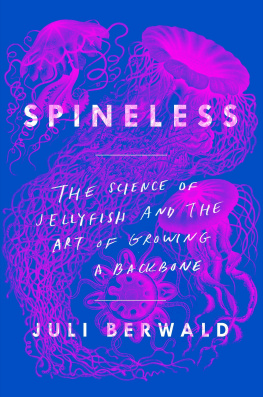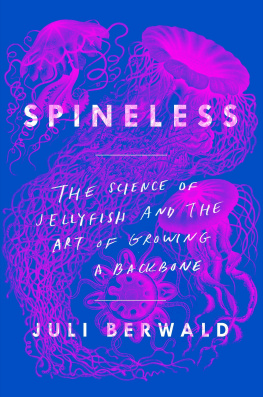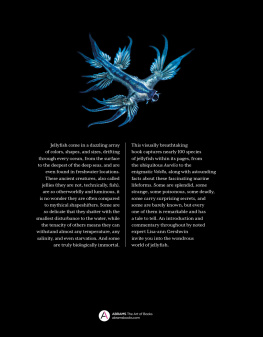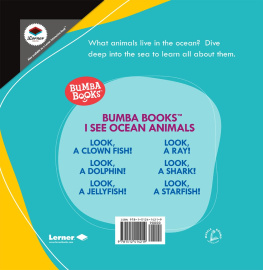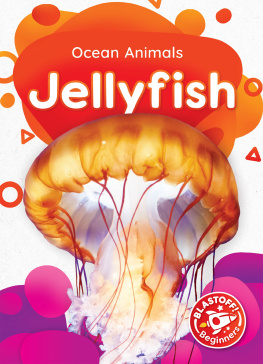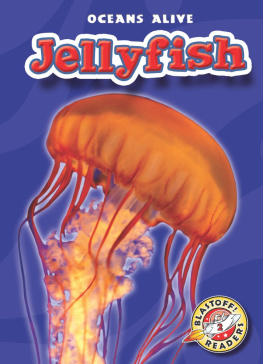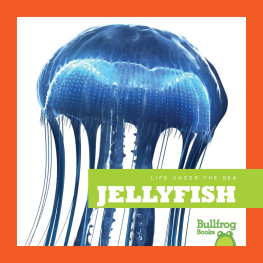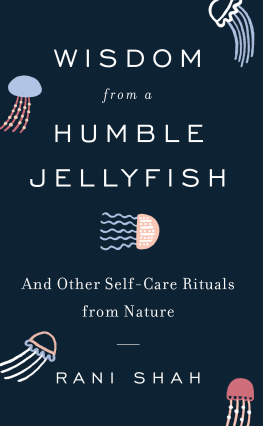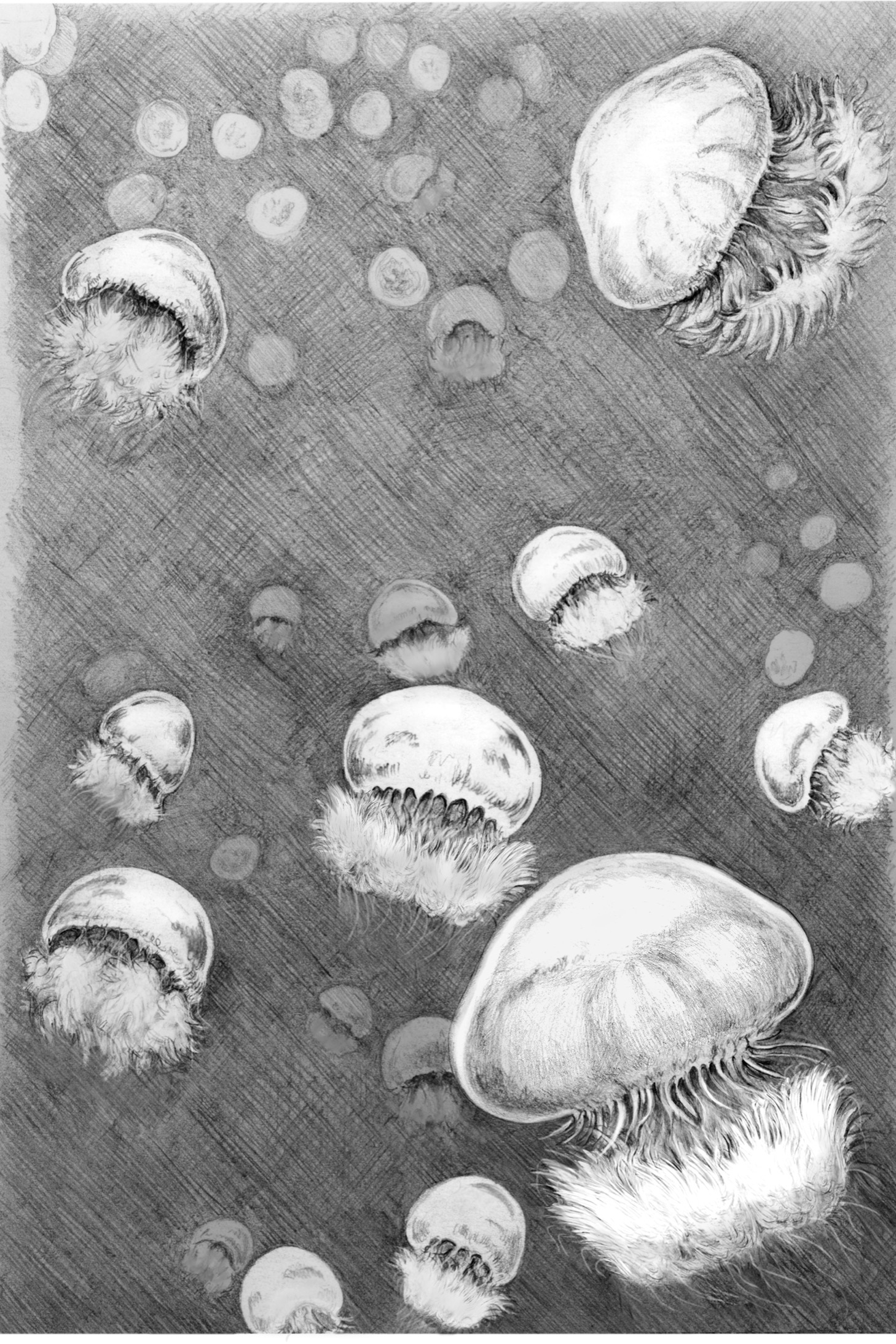
RIVERHEAD BOOKS
An imprint of Penguin Random House LLC
375 Hudson Street
New York, New York 10014

Copyright 2017 by Juli Berwald
Penguin supports copyright. Copyright fuels creativity, encourages diverse voices, promotes free speech, and creates a vibrant culture. Thank you for buying an authorized edition of this book and for complying with copyright laws by not reproducing, scanning, or distributing any part of it in any form without permission. You are supporting writers and allowing Penguin to continue to publish books for every reader.
Library of Congress Cataloging-in-Publication Data
Names: Berwald, Juli, author.
Title: Spineless : the science of jellyfish and the art of growing a backbone / Juli Berwald ; illustrations by Rachel Ivanyi.
Description: New York : Riverhead Books, 2017. | Includes bibliographical references and index.
Identifiers: LCCN 2017005838 (print) | LCCN 2017007895 (ebook) | ISBN 9780735211261 (hardcover) | ISBN 9780735211278 (ebook)
Subjects: LCSH: Jellyfishes.
Classification: LCC QL377.S4 B47 2017 (print) | LCC QL377.S4 (ebook) | DDC 593.5/3dc23
LC record available at https://lccn.loc.gov/2017005838
p. cm.
Illustrations by Rachel Ivanyi
Penguin is committed to publishing works of quality and integrity. In that spirit, we are proud to offer this book to our readers; however, the story, the experiences, and the words are the authors alone.
Version_1
For Keith
Contents
Among the most beautiful, as well as the most common, of the marine animals which are to be met with upon our coasts are the jelly-fish.... And in the memories of most of us is there not associated with the picture of breaking waves and sea-birds floating indifferently in the blue sky or on the water still more blue, the thoughts of many a ramble among the weedy rocks and living pools, where for the time being we all become naturalists, and where those who least know what they are likely to find in their search are most likely to approach the keen happiness of childhood? If so, the image of... those crystal globes pulsating with life and gleaming with all the colors of the rainbow... are perhaps the most strange, and certainly in my estimation the most delicately lovely creatures in the world.
GEORGE J. ROMANES , Jelly-fish, Star-fish and Sea-Urchins: Being a Research on Primitive Nervous Systems, 1885
If You Dare
H iroshimas downtown is a garden of modern architecture interspersed with swaths of lovely green parks. In the center, there is a single structure, in ruins, capped by a skeleton of curved iron. This is the Atomic Bomb Dome, located at the destructions epicenter, the sole building that managed to remain standing amid the massive force that flattened everything else for miles in all directions. It is an astonishing memorial to both our capacity for horrifying devastation and our awesome resilience. The dome sits along the side of one of six tidal streams that flow through Hiroshima. In the murky, green water, I watched thousandsmaybe hundreds of thousandsof pale pink disks parade by, a flood of jellyfish. Juxtaposed with the dome, the endless stream of jellyfish seemed to square off natures power against our own, a battle as old as civilization that continues to play out in the decisions we make today. They were the first wild jellyfish I saw in years of chasing jellyfish. The milky creatures pulsed slowly, slower than my heartbeat, which dropped as I watched. The movements of their bells trailing gossamer tentacles were like millions of eyelashes blinking open and closed and open again, giving me a feeling that these alien animals could peer deep into the soul of the sea. I found it impossible to fathom the source of this endless river of life. The jellies continued to flow by for as long as I stood and watched.
Maybe you remember the first time you saw a jellyfish. Maybe you were lucky enough to stick your head under the oceans surface, wearing a mask, and watch the primal undulations of a jellyfish dancing to some internal rhythm. Maybe you felt a biting sting in the water and turned to see a gelatinous blob disappear like sinking mucus. Maybe you stood against the glass and watched the elegant clover on the back of a moon jellyfish or the graceful train of a sea nettle in an aquarium. Or maybe it was footage of jellyfish hawking a cure for memory loss.
I dont remember the very first jellyfish I saw. I grew up in a time before aquaria were full of jellyfish tanks, in a very landlocked St. Louis. I never spent an extended period near the ocean until I was in college. In my junior year, 1987, I attended an English-speaking study-abroad program in Tel Aviv. From a New England school where getting ready to go to a party meant putting on tattered jeans, a flannel shirt, and duck boots, I was a misfit among the other American students, who were a lot less style-challenged. I found the Israelis my age no easier to get along with. At nineteen, they were required to serve in the army, while I had the freedom to jaunt off to college unencumbered.
I stuffed my loneliness down with the hummus and baba ghanoush sold from a cart on the street corner near my cinder-block dorm. At about the same rate that my weight increased, my spirits sank. One day, I opened the door to the building where my class on Middle Eastern politics was held and spotted a sign out of the corner of my eye. It advertised a marine biology course: a week in Eilat, at the southern tip of Israel, studying the ecology of the Red Sea. Knowing next to nothing about biology or Eilat, not to mention the fact that I was hardly able to squeeze into my swimsuit anymore, I scrawled my name at the bottom of the list. It was clear I needed to put some distance between me and the pita cart.
A few days later, with about twenty other students, I boarded a bus headed south at dawn. After a five-hour ride through the desert, we were offloaded and handed snorkels, masks, and fins. I think there was a quick instruction on keeping hands away from urchin spines and fire coral. I shuffled down the beach backward, the only way to walk in fins. When I slipped my face below the waters surface, it was as if I were Dorothy stepping into Oz. My dull, sad world erupted in a kaleidoscope of colors, shapes, and textures. I glided over creatures that I could never have imagined existed in my mostly landlocked life. Pink, purple, and yellow coral that branched, encrusted, and mounded. Blotchy lavender anemones, creeping crimson shrimp, twirling buff-colored worms, filigreed fans, spiked black urchins. A day-glo orange sponge with a violet slug curled around it. Bowls of lemon-, lime-, and watermelon-hued clams. Here, astonishingly, was paradise.
That evening, the professor gave a lecture detailing twenty different species of coral living on the reef. He told us to memorize them all. Walking to the dorms after class, gazing at the moons reflection on the Red Sea, I felt, for the first time in a long time, happy.

